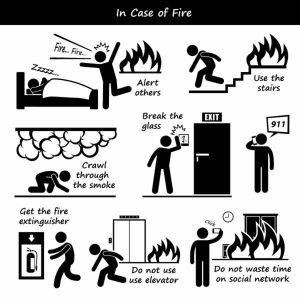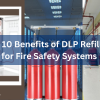![]()
Fire Immuniser
+91-7829629111
Email: info@variex.in
Varistor Technologies Pvt. Ltd.
Block-1, First Floor, Ardente Office One, Hoodi Circle, ITPL Main Road, Bengaluru, Karnataka 560048, IN
FIRE SAFETY AWARENESS: IMPORTANT POINTS TO FOLLOW IN A FIRE
Fire is very dangerous as it can destroy property, cause injuries, and take lives. A fire in the workplace can also mean a tremendous safety risk for any business, workplace, or organization, the termination of jobs, as many of the offices and factories. Fire is one of the biggest safety issues and that also sometimes overlooked or underestimated. The potential for fire in the home or workplace or public gathering building is not something to take lightly. These places can be very vulnerable considering the number of people usually present in those buildings. Therefore fire safety awareness is crucial to maintaining a safe workplace and preventing fires. With proper fire safety training, people of the particular building can eliminate fire hazards and respond quickly and efficiently if a fire breaks out.
You should follow fire safety precautions regardless of where you live. Have a look at the following fire safety issues, which can help you create a safer and more secure living environment (fire prevention and fire protection) for you, your family, friends, and business.
Fire Safety Awareness Infogram –
 (Image Source: Tutocare.co.uk)
(Image Source: Tutocare.co.uk)
Escape Plans
Fire can happen in every building whether you sleep, study, or work there, hence you should always have an escape plan. In that case, you may need to escape within a few minutes of a fire’s start. Comprehending this fact in mind, your safe exit should be dependent on an immediate warning from smoke alarms and planning of escape routes.
Some of the basic rules of Escape Plan are as follows:
- It should include two ways out of every room in all escape plans.
- It should entitle a location to exit from inside of the building.
- It should be verified that smoke alarms or fire detectors are installed to provide early fire detection as well as warning of it so that you will get enough time to execute your escape plan.
- You should make sure that doors located in your path of exit can be opened from the inside under all storm or lighting conditions.
- Ensure the window can be opened from the inside and it is large enough for you to pass through the opening.
- Confirm the windowsill is low enough to allow you to crawl through the opening.
- You should also verify that doors located in your path of exit do not require a key to open from the inside of the room.
- It should conduct a roll call to verify everyone has escaped the building.
- It should take note of whether any disabled or elderly residents will require evacuation assistance.
- Make sure the sloping terrain, the location of the window, or other factors will not prevent the window from being used as a secondary escape route.
Smoke Alarms
There are thousands of home fires, which result in various deaths annually. The report says almost half of these deaths resulted from fires that were reported between the hours of 10 p.m. and 7:00 a.m. - most people sleep during this period. Therefore, the installation of smoke alarms or fire alarms in bedrooms is the most important step toward preventing fire-related casualties in residential buildings.
Some of the basic rules of Smoke Alarms are as follows:
- Install at least one smoke alarm in every bedroom.
- Locate any additional fire alarm installed on walls in hallways and common areas in the vicinity of bedrooms and at least four inches below the ceiling or no more than 12 inches below the ceiling.
- Install at least one smoke alarm on every flat of your home and ensure that the smoke alarms within your home are interconnected so the activation of one alarm will activate all alarms within your house.
- Do not install smoke alarms in the corners of rooms, do not fix fire alarms next to air-conditioning vents, heating vents, or ceiling fans, do not install smoke alarms in kitchens or bathrooms to ensure the proper functioning of the unit rather not to prevent false alarms.
- Test fire alarms or smoke detectors or heat detectors at least once a month, by pressing their button that allows you to test the unit.
- Replace smoke alarms every 10 years.
- Smoke alarms with any other type of battery need a new battery at least once a year.
Candles and Incense
Use of candles and incense are open flames that pose a threat of fire - mostly candle fires take place in the bedroom if they are left unattended.
Some of the basic rules of Candle and Incense Basics are as follows:
- Remember that the safest option is not to have candles and burning incense in your home.
- Never leave candles or incense unattended, and always extinguish them before leaving the room; keep candles and incense away from curtains, clothing, books and newspapers, and other combustible items.
- Keep candles and incense away from flammable liquids such as alcohol, oil, etc.
- Use durable candle holders, which are made of non-combustible materials to collect wax drippings, and don’t tip over easily.
- Extinguish taper and pillar candles when their wax melts down to within two inches of the holder.
- Do not use candles during blackouts, and always avoid carrying lit candles whenever possible.
Cooking
Cooking fires are the foremost cause of household fire injuries- most of which start with the ignition of common household items, including grease, paper, cabinets, and curtains.
Some of the basic rules of Cooking Safety Basics are as follows:
- Never leave food unattended especially while it’s cooking on the stove.
- Maintain a clean and tidy cooking area that should free of items such as cloth (curtains, potholders, towels, etc.), paper (cookbooks, food packaging, newspapers, etc.), and plastic (food packaging, storage containers, etc.).
- Always keep a potholder and never use a wet potholder or oven mitt, to avoid scalding when the moisture in the cloth heats up.
- Never plug microwaves into extension cords.
- Don't remove the stovetop’s lid until it is completely cool.
- Never pour water on a grease fire and discharge any type of fire extinguisher onto a pan fire since it can splatter burning grease out of the pan and spread the fire.
- Keep the oven door closed to prevent you and your clothes from catching fire.
- Unplug the microwave to remove the source of heat
- Keep your children and pets away from cooking areas and notify other occupants, and evacuate the building.
Smoking
Smoking materials are the leading cause of fire-related deaths - the most commonly ignited items in these fatal fires are mattresses and bedding, upholstered furniture, and floor coverings.
Some of the basic rules of Smoking Fire Safety are as follows:
- Smoke outside, and never smoke in an area where oxygen tanks are being used.
- Don’t smoke if you are sleepy, have been drinking, or have taken medicine or other drugs that impair your ability to handle smoking materials correctly.
- Use deep, wide ashtrays on a sturdy surface and make sure ashes are extinguished by soaking them in water before discarding them.
- Consider using fire-safe cigarettes, which are less likely to cause fires.
Electricity
Electric equipment poses serious fire safety equipment threats that can even be deadly, especially when equipment is used incorrectly.
Some of the basic rules of Electrical Safety Basics are as follows:
- Protect electrical outlets with plastic safety covers.
- Never operate electrical appliances around bathtubs, showers, or pools of standing water.
- Replace or repair frayed, loose, or otherwise damaged cords on all electronics.
- Shut off the circuit and get it checked by an electrician if any switches feel warm.
- Place lamps on level surfaces, away from flammable items, and use light bulbs that match the lamps’ recommended wattages.
- Avoid running extension cords across doorways or under carpets and overloading circuits by plugging too many items into the same outlet.
- Connect power strips and surge protectors directly into a wall outlet and not to connect multiple power strips or surge protectors together.
Laundry
Laundry equipment poses a serious fire risk because they involve electricity, and the combination of combustible clothing, and extremely hot temperatures. The vast majority of laundry fires are caused by dryers, which are not cleaned properly.
Some of the basic rules of Dryer Safety Basics are as follows:
- Have dryers installed and serviced by a proficient professional and get those inspected periodically by a professional to ensure the gas line and its connection are intact.
- Make sure that the dryer is plugged into an outlet that meets its electrical needs, so it doesn’t overload the trip circuit breakers or blow fuses.
- Keep the area around the dryer clear of boxes, clothing, and other combustibles and turn the dryer off when leaving home.
Gasoline
Each year gasoline causes several thousand household fires. It is a volatile liquid constantly releasing flammable vapors, which are heavier than air and accumulate at the lowest point in an area. If released inside a building, these vapors sink to floor level and spread out across the room.
Some of the basic rules of Gasoline Safety Basics are as follows:
- Never use gasoline inside the home and to wash mechanical parts.
- Never use gasoline to start a fire in cooking grills.
- Never use gasoline as a replacement for kerosene or diesel.
- Do not store gasoline near potential ignition sources, including gas-fired water heaters that contain a pilot flame.
- Follow all manufacturers’ instructions when using electronics near gasoline.
- Clean up spills immediately and discard clean-up materials properly.










Thanks for sharing these essential fire and safety basics! It’s crucial to stay informed and prepared for potential emergencies.
good